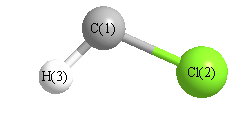Jump to
S2C1
Energy calculated at LSDA/6-31G
| | hartrees |
|---|
| Energy at 0K | -497.320564 |
| Energy at 298.15K | -497.320382 |
| HF Energy | -497.320564 |
| Nuclear repulsion energy | 36.407107 |
The energy at 298.15K was derived from the energy at 0K
and an integrated heat capacity that used the calculated vibrational frequencies.
Geometric Data calculated at LSDA/6-31G
Point Group is Cs
Cartesians (Å)
| Atom |
x (Å) |
y (Å) |
z (Å) |
|---|
| C1 |
0.047 |
1.277 |
0.000 |
| Cl2 |
0.047 |
-0.537 |
0.000 |
| H3 |
-1.086 |
1.470 |
0.000 |
Atom - Atom Distances (Å)
| |
C1 |
Cl2 |
H3 |
| C1 | | 1.8148 | 1.1495 |
Cl2 | 1.8148 | | 2.3049 | H3 | 1.1495 | 2.3049 | |
 More geometry information
More geometry information
Calculated Bond Angles
| atom1 |
atom2 |
atom3 |
angle |
|
atom1 |
atom2 |
atom3 |
angle |
| Cl2 |
C1 |
H3 |
99.625 |
|
Electronic energy levels
Charges, Dipole, Quadrupole and Polarizability
Charges from optimized geometry at LSDA/6-31G
Charges (e)
| Number |
Element |
Mulliken |
CHELPG |
AIM |
ESP |
| 1 |
C |
-0.252 |
|
|
|
| 2 |
Cl |
0.086 |
|
|
|
| 3 |
H |
0.167 |
|
|
|
Electric dipole moments
Electric dipole components in Debye
(What's a Debye? See section
VII.A.3)
| |
x |
y |
z |
Total |
| |
-1.656 |
-0.183 |
0.000 |
1.666 |
| CHELPG |
|
|
|
|
| AIM |
|
|
|
|
| ESP |
|
|
|
|
Electric Quadrupole moment
Quadrupole components in D Å
| Primitive |
|---|
| | x | y | z |
|---|
| x |
-19.690 |
-2.642 |
0.000 |
| y |
-2.642 |
-20.386 |
0.000 |
| z |
0.000 |
0.000 |
-18.105 |
|
| Traceless |
|---|
| | x | y | z |
|---|
| x |
-0.444 |
-2.642 |
0.000 |
| y |
-2.642 |
-1.489 |
0.000 |
| z |
0.000 |
0.000 |
1.933 |
|
| Polar |
|---|
| 3z2-r2 | 3.865 |
|---|
| x2-y2 | 0.696 |
|---|
| xy | -2.642 |
|---|
| xz | 0.000 |
|---|
| yz | 0.000 |
|---|
|
Polarizabilities
Components of the polarizability tensor.
Units are
Å
3 (Angstrom cubed)
Change units.
| |
x |
y |
z |
| x |
2.291 |
-0.403 |
0.000 |
| y |
-0.403 |
5.001 |
0.000 |
| z |
0.000 |
0.000 |
1.584 |
<r2> (average value of r
2) Å
2
| <r2> |
30.204 |
| (<r2>)1/2 |
5.496 |
Jump to
S1C1
Energy calculated at LSDA/6-31G
| | hartrees |
|---|
| Energy at 0K | -497.319227 |
| Energy at 298.15K | -497.319049 |
| HF Energy | -497.319227 |
| Nuclear repulsion energy | 37.547176 |
The energy at 298.15K was derived from the energy at 0K
and an integrated heat capacity that used the calculated vibrational frequencies.
Geometric Data calculated at LSDA/6-31G
Point Group is Cs
Cartesians (Å)
| Atom |
x (Å) |
y (Å) |
z (Å) |
|---|
| C1 |
0.038 |
1.203 |
0.000 |
| Cl2 |
0.038 |
-0.532 |
0.000 |
| H3 |
-0.865 |
1.830 |
0.000 |
Atom - Atom Distances (Å)
| |
C1 |
Cl2 |
H3 |
| C1 | | 1.7356 | 1.0984 |
Cl2 | 1.7356 | | 2.5286 | H3 | 1.0984 | 2.5286 | |
 More geometry information
More geometry information
Calculated Bond Angles
| atom1 |
atom2 |
atom3 |
angle |
|
atom1 |
atom2 |
atom3 |
angle |
| Cl2 |
C1 |
H3 |
124.777 |
|
Electronic energy levels
Charges, Dipole, Quadrupole and Polarizability
Charges from optimized geometry at LSDA/6-31G
Charges (e)
| Number |
Element |
Mulliken |
CHELPG |
AIM |
ESP |
| 1 |
C |
-0.320 |
|
|
|
| 2 |
Cl |
0.116 |
|
|
|
| 3 |
H |
0.204 |
|
|
|
Electric dipole moments
Electric dipole components in Debye
(What's a Debye? See section
VII.A.3)
| |
x |
y |
z |
Total |
| |
-1.006 |
0.538 |
0.000 |
1.141 |
| CHELPG |
|
|
|
|
| AIM |
|
|
|
|
| ESP |
|
|
|
|
Electric Quadrupole moment
Quadrupole components in D Å
| Primitive |
|---|
| | x | y | z |
|---|
| x |
-18.346 |
-1.771 |
0.000 |
| y |
-1.771 |
-17.396 |
0.000 |
| z |
0.000 |
0.000 |
-19.589 |
|
| Traceless |
|---|
| | x | y | z |
|---|
| x |
0.146 |
-1.771 |
0.000 |
| y |
-1.771 |
1.572 |
0.000 |
| z |
0.000 |
0.000 |
-1.718 |
|
| Polar |
|---|
| 3z2-r2 | -3.436 |
|---|
| x2-y2 | -0.950 |
|---|
| xy | -1.771 |
|---|
| xz | 0.000 |
|---|
| yz | 0.000 |
|---|
|
Polarizabilities
Components of the polarizability tensor.
Units are
Å
3 (Angstrom cubed)
Change units.
| |
x |
y |
z |
| x |
1.611 |
-0.213 |
0.000 |
| y |
-0.213 |
4.541 |
0.000 |
| z |
0.000 |
0.000 |
1.137 |
<r2> (average value of r
2) Å
2
| <r2> |
29.153 |
| (<r2>)1/2 |
5.399 |
